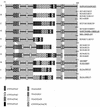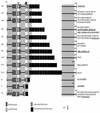Remarkable genetic polymorphism among Entamoeba histolytica isolates from a limited geographic area
- PMID: 12409379
- PMCID: PMC139687
- DOI: 10.1128/JCM.40.11.4081-4090.2002
Remarkable genetic polymorphism among Entamoeba histolytica isolates from a limited geographic area
Abstract
In order to understand genetic polymorphisms among Entamoeba histolytica strains in a limited geographic area and among restricted social populations, we studied nucleotide polymorphism in DNA regions that do not encode proteins (locus 1-2 and locus 5-6) and in genes coding for chitinase and for serine-rich E. histolytica protein. Thirty E. histolytica isolates from domestically infected Japanese amebiasis patients (male homosexuals and residents in institutions for the mentally handicapped) and four reference strains were examined. PCR revealed remarkable polymorphisms in both the number and size of the PCR fragments containing these loci. Polymorphisms in lengths, types, and numbers of internal repeat units were observed in locus 1-2 and the repeat-containing region of serine-rich E. histolytica protein among the Japanese isolates. In contrast, polymorphism at locus 5-6 was observed almost exclusively in the number of repeats of a 16-nucleotide unit. The repeat-containing region of chitinase appeared to be the least polymorphic among the four loci with a single dominant genotype representing 66% (20 out of 30) of all of the isolates. Isolates obtained from male homosexuals showed a more complex genetic polymorphism than those from residents in institutions. Considering all four polymorphic loci together, all 19 Japanese isolates from male homosexuals were distinct. In contrast, all isolates obtained from mass-infection cases at a single institution had an identical genotype, suggesting that these cases were caused by a single E. histolytica strain. No significant correlation was found between genotypes and zymodemes or between genotypes and clinical presentations, e.g., colitis or liver abscess. Certain genotypes were observed with higher frequencies in male homosexuals or residents of institutions. These data indicate that genotyping of the E. histolytica isolates by using these four polymorphic loci could serve as a tool to fingerprint individual isolates. We propose that genotyping of ameba isolates should help to determine geographic origins of isolates and routes of transmission.
Figures





References
-
- Abe, N., Y. Nishikawa, A. Yasukawa, and K. Haruki. 1999. Entamoeba histolytica outbreaks in institutions for the mentally retarded. Jpn. J. Infect. Dis. 52:135-136. - PubMed
-
- Allason-Jones, E., A. Mindel, P. Sargeaunt, and P. Williams. 1986. Entamoeba histolytica as a commensal intestinal parasite in homosexual men. N. Engl. J. Med. 315:353-356. - PubMed
-
- Ayala, F. J. 1993. Trypanosoma and Leishmania have clonal population structures of epidemiological significance. Biol. Res. 26:47-63. - PubMed
-
- Bhattacharya, S., A. Bhattacharya, and L. S. Diamond. 1992. Entamoeba histolytica extrachromosomal circular ribosomal DNA: analysis of clonal variation in a hypervariable region. Exp. Parasitol. 74:200-204. - PubMed
-
- Blanc, D., and P. G. Sargeaunt. 1991. Entamoeba histolytica zymodemes: exhibition of gamma and delta bands only of glucose phosphate isomerase and phosphoglucomutase may be influenced by starch content in the medium. Exp. Parasitol. 72:87-90. - PubMed
Publication types
MeSH terms
Substances
Associated data
- Actions
- Actions
- Actions
- Actions
- Actions
- Actions
- Actions
- Actions
- Actions
- Actions
- Actions
- Actions
- Actions
- Actions
- Actions
- Actions
- Actions
- Actions
- Actions
- Actions
- Actions
- Actions
- Actions
- Actions
- Actions
- Actions
- Actions
- Actions
- Actions
- Actions
- Actions
- Actions
- Actions
- Actions
- Actions
- Actions
- Actions
LinkOut - more resources
Full Text Sources

